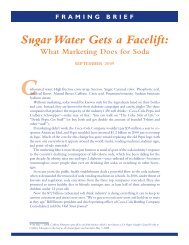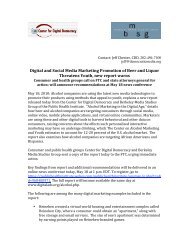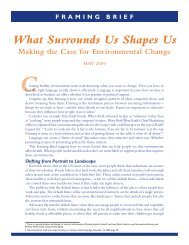"Interactive Food & Beverage Marketing" (PDF)
"Interactive Food & Beverage Marketing" (PDF)
"Interactive Food & Beverage Marketing" (PDF)
Create successful ePaper yourself
Turn your PDF publications into a flip-book with our unique Google optimized e-Paper software.
Consumers are<br />
encouraged to<br />
consider themselves<br />
the “co-creators” of<br />
the advertising and<br />
marketing.<br />
26<br />
<strong>Interactive</strong> <strong>Food</strong> & <strong>Beverage</strong> Marketing | Setting the Stage<br />
“Engagement”<br />
The concept of “engagement” is at the heart of many digital marketing campaigns<br />
targeted at children and adolescents. One of ARF’s largest-scale research efforts,<br />
which is likely to have a significant impact on the future of marketing, is the “MI4-<br />
Measurement Initiative: Advertisers, Agencies, Media and Researchers.” Sponsored by<br />
some of the most powerful institutions in the advertising industry—ARF, American<br />
Association of Advertising Agencies (AAAA), and Association of National Advertisers, Inc.<br />
(ANA)—the project is designed to “redefine marketing in the 21 st century.” The broadbased<br />
initiative includes a number of different investigations into new directions for marketing<br />
in the digital era. Working with brain researchers and psychologists, the study is<br />
focused on understanding and measuring how individual consumers “engage” with<br />
brands. 89 The engagement model relies on unconscious, “non-rational” processes. A<br />
recent article in the online digital marketing news site iMedia Connection explained the<br />
new concept, based on a conversation with ARF Chief Research Officer Joe Plummer:<br />
“The heart of engagement is ‘turning on’ a mind…. This is a subtle, subconscious process<br />
in which consumers begin to combine the ad’s messages with their own associations,<br />
symbols and metaphors to make the brand more personally relevant.” 90<br />
Using this model, advertisements are not designed to articulate the compelling,<br />
factual features and benefits of products, but rather to “seduce the consumer into beginning<br />
that subconscious processing of the brand.” As Plummer told a recent industry gathering,<br />
“storytelling is more powerful than argumentation.” 91 Consumers are encouraged<br />
to consider themselves the “co-creators” of the advertising and marketing. They are invited<br />
into creating relationships with brands through the use of celebrities and popular cultural<br />
content. 92 The March 2006 issue of The Journal of Advertising Research was<br />
focused solely on “Emotion in Advertising.” As one of the authors explained,<br />
Brands are emotionally anchored. A brand in the brain is made up of<br />
sets of cells that communicate with each other situated in different<br />
parts of the brain. This is called a brand representation. Brands are<br />
cognitively and emotionally encoded in the brain. It is the emotional<br />
anchoring of the brand that determines how we process information<br />
about it, what we notice about it, and how open we are to its initiatives.<br />
The more positively the brand is anchored, the better its chances<br />
of achieving its ambitions. [italics in the original] 93<br />
ARF is working with experts in the field of psychophysiology and neuroscience,<br />
as part of its “Emotional Response to Advertising” effort, to develop an “engagement<br />
measurement model” for identifying and testing “quantitative measures of behavior and<br />
emotion feelings.” 94









